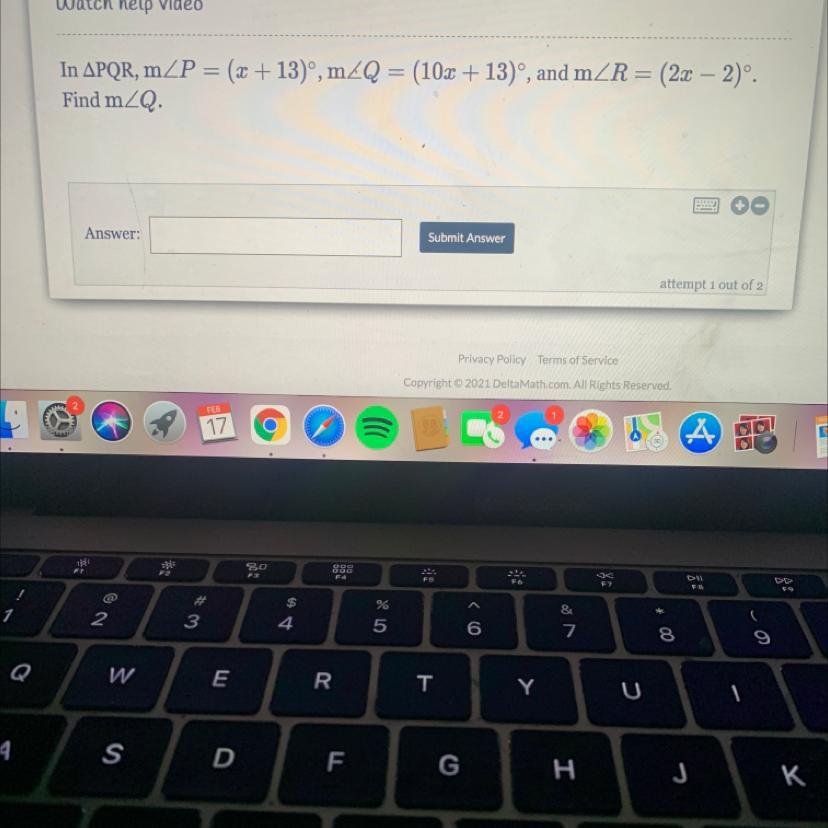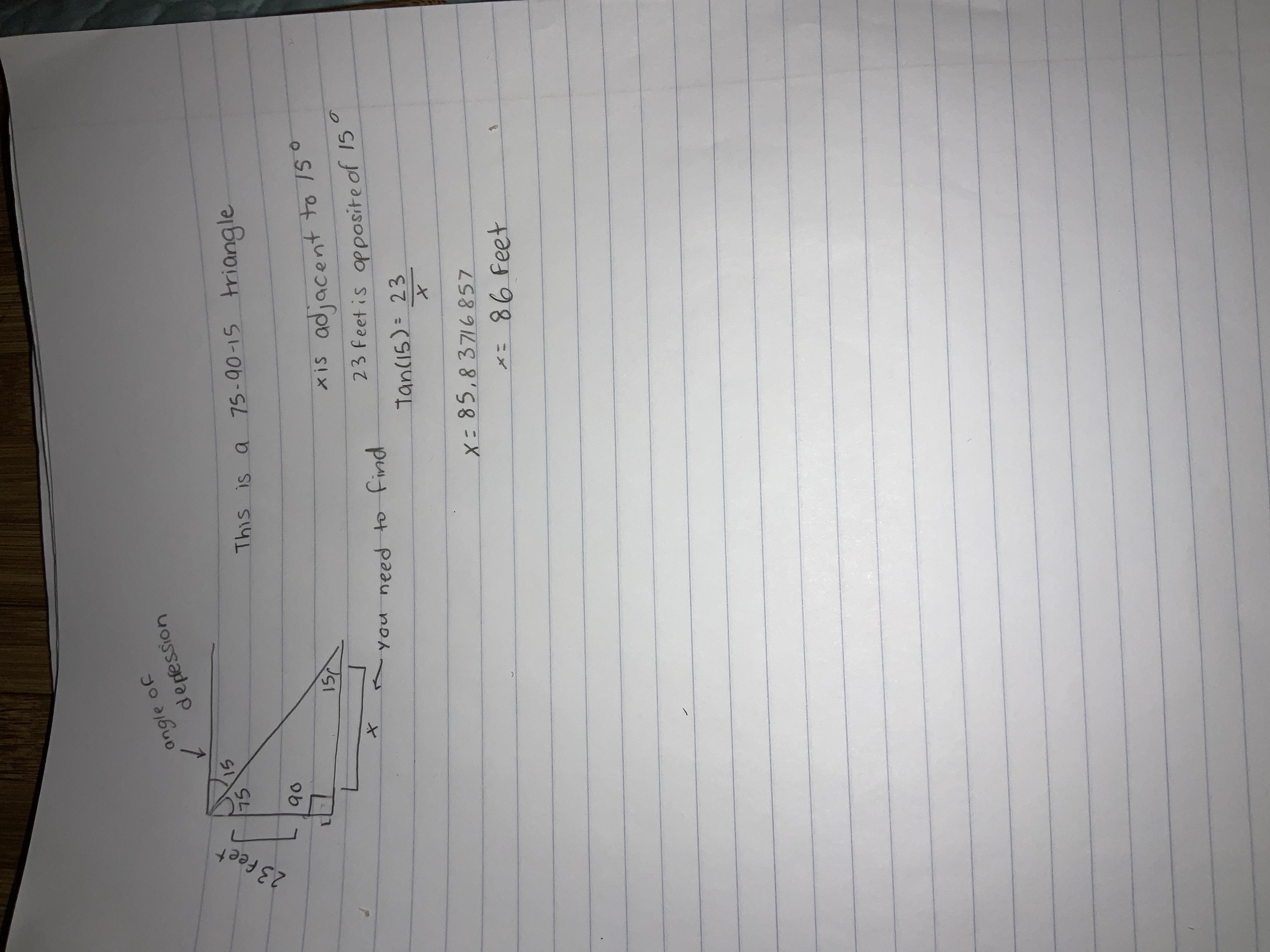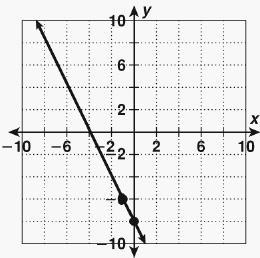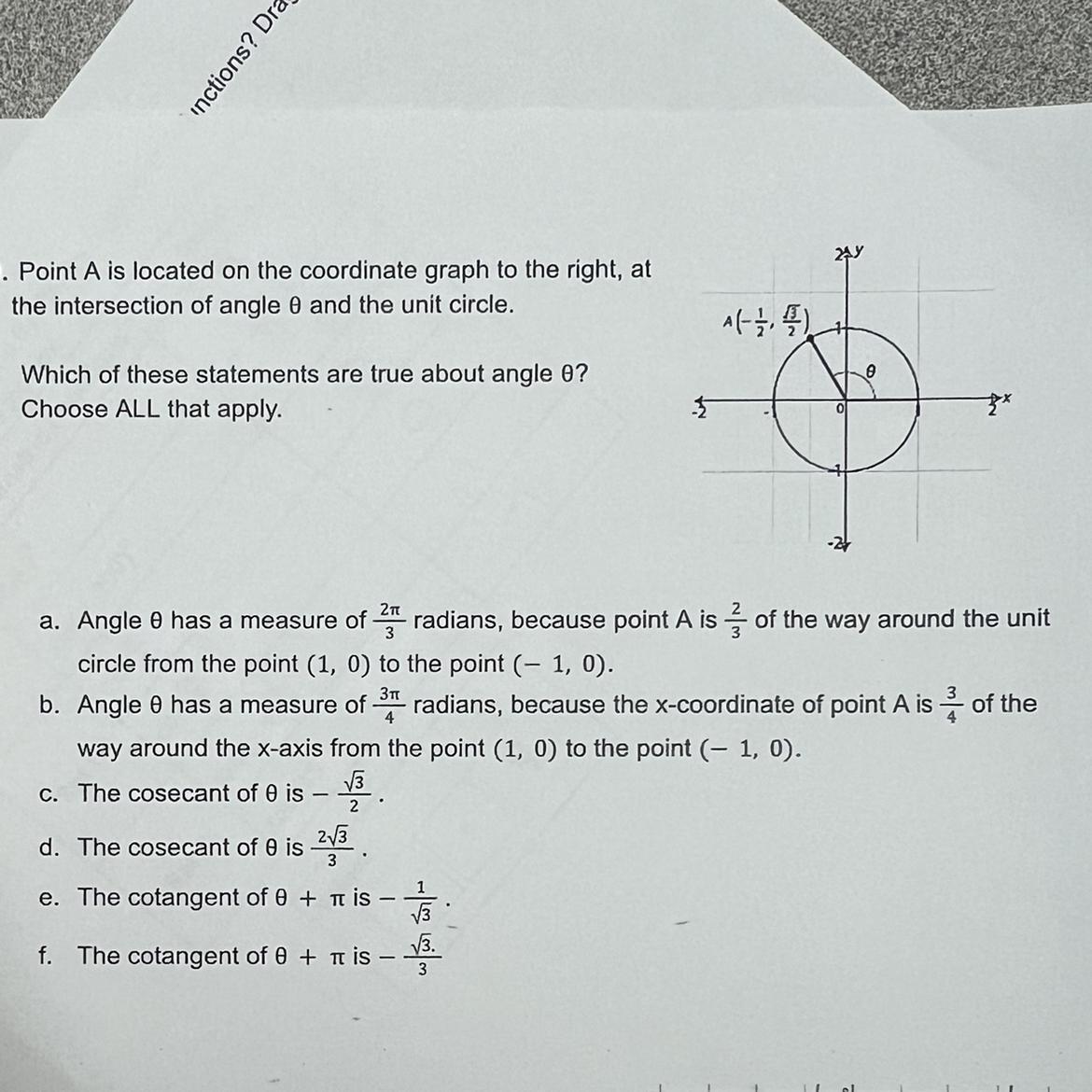Select all the triangles below which are all translations of triangle x.
Answers
All the triangles which are all translations of triangle x include the following:
triangle A triangle F.What is a translation?In Mathematics and Geometry, the translation of a geometric figure to the left simply means subtracting a digit from the numerical value on the x-coordinate of the pre-image.
On the other hand, the translation of a geometric figure downward simply means subtracting a digit from the numerical value on the positive y-coordinate (y-axis) of the pre-image.
In conclusion, only triangles A and F are translations of triangle x because they represent a rigid transformation where the size and shape does not change since they have congruent pre-images and images.
Read more on translation here: brainly.com/question/31559256
#SPJ1
Missing information:
The question is incomplete and the complete question is shown in the attached picture.

Related Questions
HELPPPPP ASAPPPP
Select the correct answer.
A volleyball player sets a volleyball straight up into the air. The height of the volleyball, h(t), is modeled by this equation, where e represents the
time, in seconds, after that ball was set.
= -16t2 + 20t + 6
The volleyball reaches its maximum height after 0.625 seconds. What is the maximum height of the volleyball
A. 11.625 feet
B. 12.25 feet
C. 8.5 feet
D. 1.625 feet
Answers
Answer:
The maximum height of the volleyball is 12.25 feet.
Step-by-step explanation:
The height of the volleyball, h(t), is modeled by this equation, where t represents the time, in seconds, after that ball was set :
\(h(t)=-16t^2+20t+6\) ....(1)
The volleyball reaches its maximum height after 0.625 seconds.
For maximum height,
Put \(\dfrac{dh}{dt}=0\)
Now put t = 0.625 in equation (1)
\(h(t)=-16(0.625)^2+20(0.625)+6\\\\h(t)=12.25\ \text{feet}\)
So, the maximum height of the volleyball is 12.25 feet.
Answer:
The correct answer is B. 12.25 feet.
Step-by-step explanation:
I got it right on the Edmentum test.
Find and solve a system of linear equations to answer the question below.
Joanne buys one kilogram of French Roast and one kilogram of Boxer Blend
from the Java Hut. Jacob buys two kilograms of French Roast and three
kilograms of Boxer Blend. If Joanne spends $14 for her purchase, and Jacob
spends $36 for his, what is the price of one kilogram of Boxer Blend coffee? Please help!!
Answers
Answer:
$8
Step-by-step explanation:
Let f = 1 kg of French Roast coffee
Let b = 1 kg of Boxer Blend coffee
Given:
Joanne buys 1 kg of French Roast and 1 kg of Boxer Blend. Joanne spends $14 for her purchase.⇒ f + b = 14
Given:
Jacob buys 2 kg of French Roast and 3 kg of Boxer Blend. Jacob spends $36 for his purchase.⇒ 2f + 3b = 36
Rewrite the first equation to make f the subject:
⇒ f + b = 14
⇒ f = 14 - b
Substitute this into the second equation and solve for b:
⇒ 2f + 3b = 36
⇒ 2(14 - b) + 3b = 36
⇒ 28 - 2b + 3b = 36
⇒ 28 + b = 36
⇒ 28 + b - 28 = 36 - 28
⇒ b = 8
Therefore, the price of 1 kg of Boxer Blend coffee is $8
\(\frac{1}{2} (5x - 9 ) = 2 (\frac{1}{3} + 6 )\)
Answers
Answer: 103/15
Step-by-step explanation:
We can simplify the right-hand side to be \(2 \left(\frac{1}{3}+6 \right)=2 \left(\frac{19}{3} \right)=\frac{38}{3}\).
This means we need to solve:
\(\frac{1}{2}(5x-9)=\frac{38}{3}\\5x-9=\frac{76}{3}\\5x=\frac{103}{3}\\x=\boxed{\frac{103}{15}}\)
please help me thank youuu

Answers
Answer:
m<Q = 133°
Step-by-step explanation:
From the question given above, the following data were obtained:
m<P = (x + 13)°
m<Q = (10x + 13)°
m<R = (2x – 2)°
m<Q =?
Next, we shall determine the value of x. This can be obtained as follow:
m<P + m<Q + m<R = 180 (sum of angles in a triangle)
(x + 13)° + (10x + 13)° + (2x – 2)° = 180
x + 13 + 10x + 13 + 2x – 2 = 180
x + 10x + 2x + 13 + 13 – 2 = 180
13x + 24 = 180
Collect like terms
13x = 180 – 24
13x = 156
Divide both side by 13
x = 156 / 13
x = 12
Finally, we shall determine m<Q. This can be obtained as follow:
m<Q = (10x + 13)°
x = 12
m<Q = 10(12) + 13
m<Q = 120 + 13
m<Q = 133°
In 1950, a U.S. population
model
was y = 151. (1.013)^t-1950 million
people, where t is the year. What did
the model predict the U.S. population
would be in the year 2000?
Answers
In a case whereby In 1950, a U.S. population model was y = 151. (1.013)^t-1950 million people, where t is the year, the model predict the U.S. population would be 288 million in the year 2000.
What is population model ?Population models are mechanical theories that link alterations in population structure and density to responses at the individual level (life history features in eco-evolutionary theory or vital rates in demographic theory).
The model was given as y=151x(1.013)^t-1950
where the future time t = 2000
Then we can substitute the given year 2000 as the value of 't'
then we will have y=[151x(1.013)^(2000-1950)] = 288 million
Learn more about model at:
https://brainly.com/question/24448358
#SPJ1
If bc= 12 and cd is 5 then bd =
Answers
Answer:
bd would also equal 5 i love math
Step-by-step explanation:
Answer:
There's no diagram.
I guess You forgot to send.
I'll guess its a quadrilateral.
Draw out a little quadrilateral...eg a rectangle
Label your points.
From the labelling ... Distance BD is now the diagonal of the rectangle.
Using Pythagorean theorem to get it...
BD = √12²+5²
BD=13.
An underhand serve follows the same parabolic path but is hit from a height of 3 feet. How will this affect the focus and directrix
Answers
the focus and directrix will both be shifted down 3 units
Haymitch Abernathy who are they? and three traits? Hunger games
Answers
Answer:
Personality… stubborn, temperamental, and frequently surly. He is often curt: “Here's some advice – stay alive.” But over the course of the Hunger Games, Haymitch becomes a true mentor to Katniss and Peeta. As a trainer, it's his job while in the Capitol to get sponsors for his Tributes
A car travels at a speed of 41 meters/second using 756 joules of energy every second. Suppose we know that the car uses 52,700 joules of energy. Set up a calculation to find the number of meters the car travels with this amount of energy.
Drag each tile to the correct location. The tiles can be used more than once.
Js141756
Answers
Answer: the car travels 2,870 meters with 52,700 joules of energy.
Step-by-step explanation:
The given car uses 756 joules of energy every second. So, it would use x amount of energy to travel for t seconds. We know that the car uses 52,700 joules of energy. Let's find the time first.T = E ÷ P = 52,700 ÷ 756 = 70 seconds.
Now, we can calculate the distance covered by the car with this amount of energy.
Distance = Speed × Time = 41 m/s × 70 s = 2,870 meters.
Therefore, the car travels 2,870 meters with 52,700 joules of energy.
consider a system using a multilevel feedback queue scheduler. its scheduler is configured to have four queues, which are, in order of highest priority to lowest priority: q1, q2, q3, and q4. the queues have quantums sized 5s, 10s, 20s, and 40s, respectively. for each of the following three processes, determine which queue it is in when it begins its final quantum
Answers
In this example, process A completed its final quantum in q4, process B completed its final quantum in q4, and process C completed its final quantum in q4.
To determine which queue each process is in when it begins its final quantum, we need to know the length of time each process has been running and how many times it has already used each queue's quantum. Without that information, we cannot determine which queue a process will be in at a specific point in time. However, we can provide an example of how a process might move between the queues over time.
Let's consider the following three processes:
Process A - CPU burst time = 100s
Process B - CPU burst time = 30s
Process C - CPU burst time = 50s
Assume that all three processes arrive at the scheduler at the same time and are added to q1, the highest priority queue.
When the scheduler begins, it will select the first process in q1, which is process A. Since q1 has a quantum of 5s, process A will run for 5s before it is preempted and placed at the back of q2.
The next process in q1 is B. B will also run for 5s before being preempted and placed at the back of q2.
Next, the scheduler will select process C from q1. C will run for 5s before being preempted and placed at the back of q2.
Now the scheduler has completed one round-robin cycle through q1, and all the processes in q1 have used up their q1 quantum. The scheduler will move on to q2 and select the first process in that queue, which is process A. Since q2 has a quantum of 10s, process A will run for an additional 5s before being preempted and placed at the back of q3.
The next process in q2 is B. B will run for 10s before being preempted and placed at the back of q3.
Next, the scheduler will select process C from q2. C will run for 10s before being preempted and placed at the back of q3.
Now the scheduler has completed one round-robin cycle through q2, and all the processes in q2 have used up their q2 quantum. The scheduler will move on to q3 and select the first process in that queue, which is process A. Since q3 has a quantum of 20s, process A will run for an additional 10s before being preempted and placed at the back of q4.
The next process in q3 is B. B will run for 20s before being preempted and placed at the back of q4.
Next, the scheduler will select process C from q3. C will run for 20s before being preempted and placed at the back of q4.
Now the scheduler has completed one round-robin cycle through q3, and all the processes in q3 have used up their q3 quantum. The scheduler will move on to q4 and select the first process in that queue, which is process A. Since q4 has a quantum of 40s, process A will run for an additional 20s before completing its CPU burst.
The next process in q4 is B. B will run for 30s before completing its CPU burst.
Finally, the scheduler will select process C from q4. C will run for 40s before completing its CPU burst.
However, it's important to note that the exact behavior of the scheduler will depend on the length of time each process has been running and how many times it has already used each queue's.
To learn more about process here:
https://brainly.com/question/28337596
#SPJ4
The Photography Club has 14 members, 10 girls and 4 boys. What is the ratio
of girls to boys in the Photography Club?
A. 5:2
B. 2:5
C. 1.2
Answers
Answer:
A
Step-by-step explanation:
Divide them both by 2 an you get 5 and 2. Since the question says girls to boys then you out the girls first. so 5:2
What algebraic expression represents "the product of x cubed and the absolute value of y"?
Answers
Answer:
\(\large\boxed{x^3*|y|}\)
Step-by-step explanation:
Hi there!
Wording: The product of x cubed and the absolute value of y.
We know that:
Product = multiply
Cubed = x³ (to the third power)
Absolute value = |x| (a negative in these lines will be positive)
Write out the scenario based on the brief definitions above:
The product of x cubed and the absolute value of y
\(\large\boxed{x^3*|y|}\)
Let me know if you have any questions!
A forest ranger spots a fire from 23-foot tower. The angle of depression from the tower to the fire is 15 degrees

Answers
Answer:
86 feet i think
Step-by-step explanation:

Yo i just need an answer and explanation for one and i'll be good for the rest

Answers
Answer:
1/5
Step-by-step explanation:
4 red + 4 yellow + 2 blue = 10 in total
2 blue out of all the colors = 2/10
2/10 simplified = 1/5
Answer:
20% or 2/10
Step-by-step explanation:
Since there are 10 slots, and two of them are blue, for each spin there will be a 2/10 chance that the arrow will land on a blue slot.
Given the following formula, solve for a
I WILL GIVE BRAINLIST!!

Answers
Answer:
a=2s-b-c
Step-by-step explanation:
2s=a+b+c
a=2s-b-c
Answer:
2s-c-b =a
Step-by-step explanation:
s = ( a+b+c)/2
Multiply each side by 2
2s = ( a+b+c)/2 *2
2s = a+b+c
Subtract c from each side
2s -c = a+b+c-c
2s -c = a+b
Subtract b from each side
2s-c-b = a+b-b
2s-c-b =a
0; 0.8; 1.6; 2.4;
write down the next 4 numbers in the sequence
Answers
Using the pattern, the next 4 numbers in the sequence would be
3.2; 4.0; 4.8; 5.6
How to find the next four termsThe given sequence seems to follow a pattern where each term is obtained by adding 0.8 to the previous term.
hence this is an AP sequence, with a common difference of 0.8, adding 0.8 to each term gives the next consecutive term
2.4 + 0.8 = 3.2
3.2 + 0.8 = 4.0
4.0 + 0.8 = 4.8
4.8 + 0.8 = 5.6
Learn more about sequence at
https://brainly.com/question/6561461
#SPJ1
Review graph I and graph II.
On a coordinate plane, a parabola labeled Graph 2 opens down. It goes through (negative 2, 0), has a vertex at (negative 2, 7), goes through open circle (negative 4, 5), and goes through (negative 6, 0).
On a coordinate plane, a parabola labeled Graph 1 opens down. It goes through (negative 2, 0), has a vertex at (negative 2, 7), goes through open circle (negative 4, 5), and goes through (negative 6, 0). An open circle is at (negative 4, 8).
Which statement compares the limit as x approaches –4 for the two graphs?
In both graph I and graph II, the limit is 5.
In both graph I and graph II, the limit does not exist.
In graph I, the limit does not exist, but in graph II, the limit is 5.
In graph I, the limit is 8, but in graph II, the limit does not exist.
Answers
Answer:
A - in both graph I and graph II, the limit is 5
Step-by-step explanation:
:)
Answer:
A - in both graph I and graph II, the limit is 5
Step-by-step explanation:
the guy above me lol
A line with a slope of 1 passes through the point (4,2). What is its equation in
slope-intercept form
Answers
Answer:
y = x -2
Step-by-step explanation:
Equation of the line : y =mx + b
m = 1
y = 1x + b
Plugin x = 4 and y =2 in this equation
2 = 1*4 + b
2 -4 = b
b = -2
Equation: y = x - 2
hey does anyone know whats life is
Answers
Answer:
life is a test to see if you will go to heaven :)
Step-by-step explanation:
Triangle B = 10cm
H = 4cm
area =
Answers
Answer:
I think it's 20
Step-by-step explanation:
10x4÷2 because vase times height,the divide by 1/2 which it 2 so answer is 20
1+1 solve it solvesolve it solvesolve it solve
Answers
JOSON Ortiz Budgeting Basics with Autumn Autumn is 22 years old and works as a checker at a local grocery store. Autumn lives in an apartment she shares with two other roommates. Autumn's take-home pay from her job is $1275.00 per month. Add this amount to her bank registry below. Here is a list of how Autumn will be budgeting her money this month. Move the expenses over to the bank registry and deduct them from the balance. Rent - $400.00 Utilities- $75.00 Cell Phone - $80.00 Subway Pass - $120.00 Groceries - $200.00 Work Clothes- $100.00 Entertainment $100.00 Savings $200.00 Transaction Paycheck Withdrawal Deposit Ending Balance Balance
Answers
Autumn's bank registry will be :
Transaction Amount Balance
Paycheck $1275.00 $1275.00
Rent $400.00 $875.00
Utilities $75.00 $800.00
Cell Phone $80.00 $720.00
Subway Pass $120.00 $600.00
Groceries $200.00 $400.00
Work Clothes $100.00 $300.00
Entertainment $100.00 $200.00
Savings $200.00 $0.00
How to explain the informationAs you can see, Autumn has $0.00 left over at the end of the month. This means that she is spending more money than she is earning. In order to create a budget that works for her, Autumn will need to find ways to cut back on her expenses. Some possible areas where she could cut back include:
Autumn could look for a cheaper apartment or move in with more roommates. Autumn could turn off lights and appliances when she's not using them and seal up any cracks or holes in her apartment to keep the heat in during the winter and the cool air in during the summer.
By cutting back on her expenses, Autumn can create a budget that works for her and save money for the future.
Learn more about transactions on
https://brainly.com/question/1016861
#SPJ1
A student paid 256.37 in school fees how much has he paid to the nearest hundred
Answers
Answer:
300
Step-by-step explanation:
256.37 5 and 6 is high enoughh to boost that 2 up to a 3
Answer:
uhhh 256.37 is rounded to the nearest hundreth
Unless you mean hundred thwn it would be 300
What is the slope of the line graphed below?

Answers
Solve the two linear inequalities graphically. Find the region that satisfy both inequalities?

Answers
The inequalities are given
\(x>7,y\ge-4\)The graph of the inequalities are
The green line represents the y inequality and blue line represents the x inequality.
The common point between these two inequalities from the graph is
\((7,-4)\)
six more than twice a number is ten. find the number 8th grade math
write the equation
solve for the variable
Answers
Answer:
x = 2
Step-by-step explanation:
Equation: 2x + 6 = 10
2x = 4
x = 2
Answer:
let the number be x
then
2x + 6 = 10
2x = 10-6
2x = 4
x = 2
mark me as brainliest
Which of the following can be a common denominator for the fractions 3/5 and 4/9?
A. 45
B. 40
C. 9
D. 5
Answers
Answer:
A
Step-by-step explanation:
The common denominator for the fractions 3/5 and 4/9 is 45
What is the lowest common multiple?The smallest number or quantity that is exactly divisible by each member of a set of numbers is called LCM.
Given two fractions, 3/5 and 4/9
The LCM of the denominators 5 and 9 is 45.
Hence, the common denominator for the fractions 3/5 and 4/9 is 45
For more references on lowest common multiple, click;
https://brainly.com/question/26505288
#SPJ3
Mary saw two poison dart frogs. One was 7/8 inch long and the other was 5/8 inch long. How much longer was one than the other?
Answers
The one poison dart frog is 1/4 inch longer than the other.
What is Poison dart frog?
A family of frogs known as the Dendrobatidea that are indigenous to tropical Central and South America go by the common name "poison dart frog." These species are nocturnal and frequently have colorful bodies. These aposematic species have a bright coloration that is linked to the species' toxicity.
Given: Mary saw two poison dart frogs.
One was 7/8 inch long and the other was 5/8 inch long.
So, 7/8 - 5/8 = 2/8 = 1/4
Hence, the one poison dart frog is 1/4 inch longer than the other.
To know more about poison dart frog, click on the link
https://brainly.com/question/28695006
#SPJ1
Need help answering this question.

Answers
Using central angle theorem, we can conclude that the options a, d and e are correct options.
Define central angle theorem?The term "central angle" refers to the angle that a circle's arc forms at the middle. The arms of the central angle are defined by the radius vectors.
In other words, it is an angle whose vertex is the centre of a circle and whose arms are the circle's two radii and intersect at two distinct locations. These two points come together to form an arc. This arc's central angle corresponds to the circle's central angle.
The central angle of a circle is the angle that an arc takes up in the centre. The radius vectors are what make up the angle's arms. Using the formula Central Angle = Arc length (AB) / Radius (OA) = (s 360°) / 2r, where s is the arc length and r is the circle radius, one may determine the central angle.
Therefore, options, a, d and e are the right options.
To know more about central angle theorem, visit:
brainly.com/question/29545066
#SPJ1
if you are dealt 4 cards from a shuffled deck of 52 cards, find the probability of getting one Queen and three king
Answers
Answer: \(\frac{16}{270725}\)
This is the same as writing 16/270725
========================================================
Explanation:
There are 4 ways to draw a queen and 4 ways to select three kings (think of it like saying there are 4 ways to leave a king out). That produces 4*4 = 16 ways total to draw the four cards we want.
This is out of \(_{52}C_4 = 270,725\) ways to select four cards without worrying if we got a queen and/or king. The steps to finding this number are shown below.
Divide the two values found to get the final answer \(\frac{16}{270725}\)
--------------------
Scratch Work:
Computing the value of \(_{52}C_4\)
Plug in n = 52 and r = 4 into the combination formula below
\(_{n} C _{r} = \frac{n!}{r!*(n-r)!}\\\\_{52} C _{4} = \frac{52!}{4!*(52-4)!}\\\\_{52} C _{4} = \frac{52*51*50*49*48!}{4!*48!}\\\\_{52} C _{4} = \frac{52*51*50*49}{4!} \ \ \text{ .... the 48! terms cancel}\\\\_{52} C _{4} = \frac{52*51*50*49}{4*3*2*1}\\\\_{52} C _{4} = \frac{6,497,400}{24}\\\\_{52} C _{4} = 270,725\\\\\)
We use the nCr combination formula (instead of the nPr permutation formula) because order doesn't matter with card hands.